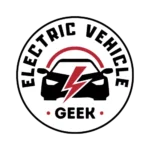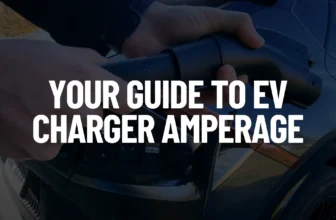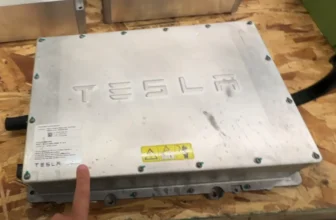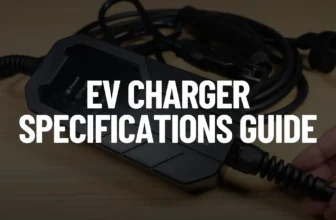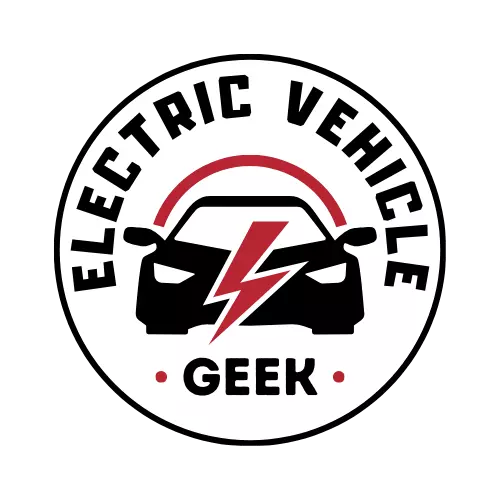Bidirectional charging enables EV owners to charge their electric cars’ batteries and pull power back to the power grid for use by other devices.
Bidirectional charging is very useful, especially for EV owners using renewable energy to charge their vehicles. They can use their EV as a backup to their home electricity when there is an outage, use their electric vehicle as a generator when camping or Overlanding, provide power during emergencies and use the opportunity to do some time-of-use arbitrage and peak shaving.
Understanding Bidirectional Charging
Bidirectional EV chargers can allow two-way charging; unlike traditional EV charging, they allow alternate current (AC) to Direct Current (DC) conversion and vice versa. This complex power conversion process allows the EV to draw power from the grid and feed excess energy back to it when needed.
Ev owners who would like to provide backup power to their homes, or specific loads such as a camper, through vehicle-to-building (V2B) charging or provide power to the grid through Vehicle to Grid (V2G) charging, or enable load to pull energy directly off the electric vehicle (Vehicle to Load (V2L).
When planning for a Bidirectional charging electric vehicle, it’s important to consider the size of the battery; an SUV with a battery size of approx 15-100 kWh will only be capable of providing backup to small homes without many electrical requirements, while larger bidirectional fleets can be used for larger bidirectional charging requirements.
In most home installations where we have installed a bidirectional charger, the homeowners have used the opportunity to power a specific part of the building, such as the garage. At the same time, others prefer powering the grid through V2G charging, especially for homeowners using renewable resources to charge their EVs.
This technology is meant to complement renewable energy sources such as solar photovoltaic (PV) and distributed energy resources (DERs) or provide backup to power buck-up tools such as generators.
How Does Bidirectional Charging Work?
When charging an electric vehicle, alternating current (AC) from the power source is converted to direct current (DC) by the onboard charger and stored in the battery, which always stores power in direct current (DC).
When needed, the EV owner can convert the direct current (DC) from the EV battery into alternating current (AC)to power their camper or home or send it back to the grid.
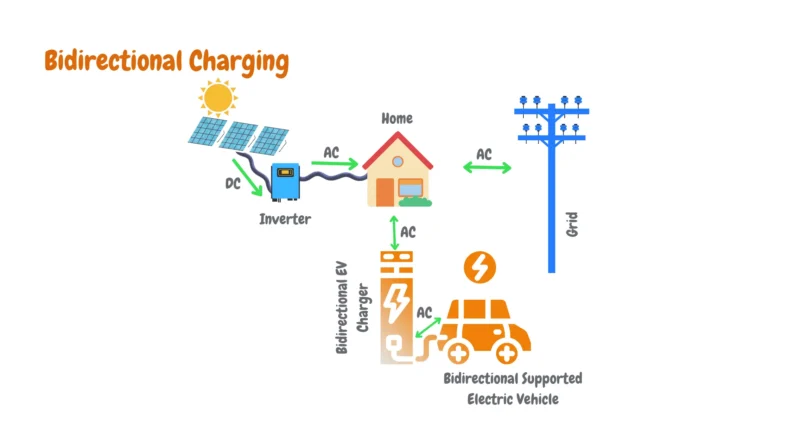
The conversion can be scheduled or triggered remotely in a smart EV charger that supports bidirectional charging. Since the conversion occurs independently through the onboard converter the bidirectional charger will manage the load and regulate the power from or to your electric vehicle batter.
Types of Bidirectional Charging?
Bidirectional EV charging can be used in various applications, including Vehicle-to-Grid (V2G), Vehicle-to-Home (V2H), Vehicle-to-Load (V2L), and Vehicle-to-Vehicle.
Vehicle-to-Grid (V2G)
Vehicle-to-Grid (V2G) involves a load management process that sends power back to the electric grid from the EV battery; stored DC power is converted to AC by the onboard charger and sent back to the grid as Alternate Current.
Vehicle-to-grid (V2G) is loved by EV owners using renewable energy to charge their EVs, when there is little to no power in the power supply system storage batteries, they use their EVs to charge the batteries or supplement additional devices connected to the grid with power,
Vehicle-to-Home (V2H)
Vehicle-to-Home (V2H) is also helpful to EV owners connected to the grid or using renewable energy to charge their EVs. Vehicle to Home (V2H) allows the EV charger to convert DC to AC and use the electricity to power their home, offices, or portable homes.
EV owners with varying energy tariffs with peaks and off-peaks can charge their vehicles during off-peak sessions and use the power stored in their vehicles to power their homes during the peak sessions to reduce their electricity bills.
Homeowners who are connected to the grid or using renewable energy to charge their EVs and are now required to charge their homes will require a power control system connected to their electrical panel by their certified electrician.
Vehicle-to-Load (V2L)
Vehicle-to-Load (V2L) electric vehicles allow the EV owner to convert power from DC to AC and use a standard power outlet to power devices connected to the standard power outlet, such as a camper, tent, etc. Some vehicles, like the Ford F-150 Lightning, come equipped with V2L capabilities via built-in bidirectional chargers and standard AC power outlets.
Vehicle-to-Vehicle (V2V)
Vehicle-to-vehicle (V2V) bidirectional charging allows one EV to charge the other; stored energy in DC is converted to AC and is again converted when charging another electric vehicle to DC to allow the electric vehicle’s battery to store the energy.
Vehicle-to-Vehicle (V2V) is ideal for businesses with lots of electric vehicles, businesses or individuals with multiple electric vehicles, and homeowners with two or more electric vehicles; this is because using Vehicle-to-Vehicle (V2V) bidirectional charging allows the vehicles to charge each other.
Benefits of Bidirectional Charging
Being able to use your electric vehicle to power other devices has lots of advantages both to the EV owner and the energy providers, in fact with a wide adoption of bidirectional charging, electric vehicles can themselves become part of the grid system, especially when there isn’t enough charging station due to overflooding of electric vehicles as the current power output isn’t enough to support the demand of electric vehicles by consumers.
Reduce Your Environmental Impact
When combined with renewable energy sources like solar panels, bidirectional charging brings numerous benefits for creating a greener home. Through this integrated approach, homes experience a significant reduction in reliance on conventional grid electricity, resulting in cost savings and a decreased carbon footprint.
The combination of renewable resources and energy storage also addresses the intermittent nature of renewable energy, allowing users to store excess energy in electric vehicle batteries. This dual functionality empowers individuals to actively participate in clean energy distribution, contributing to a more resilient and sustainable energy ecosystem.
Save on Electricity Bills.
Ev owners with bidirectional supported vehicles and chargers can charge their vehicles during off-peak season and use their electric vehicle battery to power other devices that need power during peak seasons; this is useful if your electric grid has peak and off-peak charging sessions or fluctuating electricity prices based on grid demand.
Typically, EV owners with bidirectional supported vehicles can charge their electric vehicles on weekday afternoons and early mornings when electricity is cheaper and use their electric vehicle battery power to power other electrical devices that need power during peak seasons, such as lights, saving on electricity bills by avoiding peak seasons.
Use an EV as a Power Back-Up.
Due to the aging electrical grid built in the 1970s and the 1980s, the electrical grid in the United States is prone to damage due to weather conditions and overload, with power outages occurring more than three times a year lasting from a couple of hours to 3 days.
Owners with an electric vehicle supporting bidirectional charging can use their electric vehicle batteries as a backup to power their homes during power outages. A typical electric vehicle battery can hold up to 60 kilowatt hours of electricity, which keeps you home-powered until power is restored. a typical 60 kilowatt hours of battery can last anywhere between a day and two days depending on your power requirements.
Power Other Devices.
EV owners with an electric vehicle that supports bidirectional charging can also use their electric vehicle battery as a portable power source to power other electric devices such as campers and tents, reducing the need of having to use a gas-powered generator for camping or overlanding, allowing you to go all green.
A portable power source can power accessories such as woodworking tools, EVs, appliances, etc.
Disadvantages of Bidirectional Charging
While bidirectional charging has its advantages, as with everything on earth, it has some disadvantages, however being a technology. service, we are sure some of the disadvantages highlighted below will be solved over time as more research, testing, and innovations occur in the new electric vehicle charging technology space.
Accelerated Battery Degradation
Bidirectional charging, a technology enabling electric vehicles (EVs) to both charge from and discharge energy back to the grid, presents a potential challenge related to accelerated battery degradation.
The bidirectional process involves increased charge and discharge cycles, which stress battery cells, elevated temperatures, and cause voltage fluctuations.
These factors can expedite chemical and mechanical changes within the battery, diminishing its overall lifespan.
Advanced battery management systems (BMS), temperature control systems, and optimized charging protocols are essential to mitigate these risks.
Cost and Complexity
While bidirectional charging promises numerous benefits, it introduces challenges related to cost and complexity. Implementing this technology necessitates specialized infrastructure and equipment, contributing to increased complexity and expenses for charging stations and electric vehicles (EVs).
The bidirectional charging infrastructure demands advanced power conversion electronics, inverters, and energy management systems to facilitate two-way energy flow. Additionally, EVs compatible with bidirectional charging must incorporate sophisticated components to handle the intricate charging and discharging processes.
The overall investment in designing, manufacturing, and installing this specialized equipment raises the financial barrier to widespread adoption.
Conclusion
Bidirectional charging represents a transformative leap in electric vehicles, unlocking many possibilities for EV owners and the broader energy ecosystem. As the technology matures and more EVs adopt bidirectional capabilities, the future promises a dynamic and resilient energy landscape where vehicles play a pivotal role in balancing, storing, and supplying power. Embracing bidirectional charging now positions EV owners at the forefront of a sustainable energy revolution.

James Ndungu is a certified EV charger installer with over five years of experience in EVSE selection, permitting, and installation. He holds advanced credentials, including certification from the Electric Vehicle Infrastructure Training Program (EVITP) and specialized training in EV charging equipment and installation, as well as diplomas in EV Technology and Engineering Fundamentals of EVs. Since 2021, James has tested dozens of EV chargers and accessories, sharing expert insights into the latest EV charging technologies.
